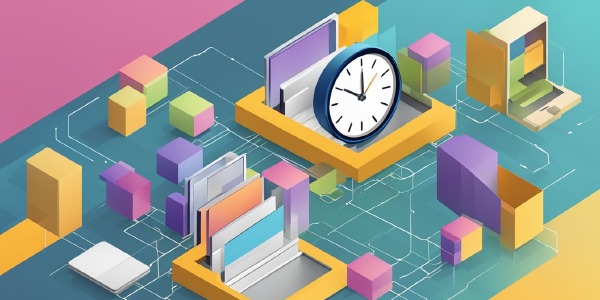Learning to Learn: Strategies to Boost Your Brainpower Efficiently
Enhancing cognitive abilities is a dynamic and continuous process that is essential in our rapid, information-rich world. Cognitive skills are the core skills your brain uses to think, read, learn, remember, reason, and pay attention. Working together, they take incoming information and move it into the bank of knowledge you use every day at school, at work, and in life. Improving these skills can lead to better work performance, improved learning, and an overall increase in productivity. It’s not just about working or learning harder, but smarter, and finding effective strategies that work for you.

Creating an optimal learning environment plays a vital role in facilitating cognitive development and mastering new skills. This involves not only organizing your physical space for minimal distractions but also tuning your mental space to embrace and integrate new information effectively. In addition to your surroundings, adopting the right learning strategies that resonate with your personal learning style can significantly improve how you process and retain information. Techniques can range from visualization and mnemonic devices to practical exercises and hands-on experiences, all aiming to bolster the way you learn.
Lifestyle factors have a profound impact on your cognitive abilities. Regular physical exercise, a balanced diet, sufficient sleep, and stress management can all contribute to better mental functioning. They lay the foundation that supports all other strategies aimed at enhancing your learning capabilities. Remaining adaptable and willing to face new challenges in learning is also crucial for continual cognitive growth, not to mention evaluating outcomes to understand and refine your learning processes further.
Key Takeaways
- Enhancing cognitive abilities is about adopting smarter, personalized learning strategies.
- An optimal learning environment and lifestyle are critical for effective cognitive development.
- Continual adaptation and outcome evaluation are necessary for sustained learning success.
Understanding Cognitive Abilities

When you explore your cognitive abilities, you’re essentially unpacking the tools your brain uses to think, learn, remember, and solve problems.
Cognitive Psychology
Cognitive psychology examines how you acquire, process, and use information. Your brain function is at the core of cognitive psychology. It’s the field that looks at how your mental processes impact your behavior. By understanding the intricacies of how your neurons work together, you gain insight into how to harness and improve your cognitive abilities.
Cognitive Skills
Your cognitive skills encompass a variety of mental capabilities, including:
- Attention: Your ability to focus on specific information while ignoring distractions.
- Perception: How you interpret sensory information to understand your environment.
- Problem-solving: The methods you use to find solutions to complex issues.
- Decision-making: Your process for making choices from available options.
These skills are founded on your working memory and long-term memory, both essential for learning and applying new information.
The Role of Memory
Memory is pivotal in your cognitive toolkit. It’s broadly divided into:
- Working memory: A temporary storage system where you manipulate information for immediate tasks.
- Long-term memory: A more permanent information repository.
Both types of memory are integral to your ability to function and learn effectively. Maintaining brain health is crucial for preserving and enhancing your memory and, by extension, your cognitive capabilities. Cognitive science continues to reveal strategies that can strengthen your brain’s neural connections and improve memory retention.
Optimizing Learning Environments

Creating an optimal learning environment is crucial for enhancing cognitive abilities. It’s essential that you consider both the physical and digital realms when tailoring a space conducive to learning.
Active and Passive Learning Spaces
When designing a learning space, balancing active and passive areas is key. Active learning spaces are designed for engagement, often featuring movable furniture to promote interaction among students and teachers. They may include whiteboards, round tables, or modular seating. On the other hand, passive learning spaces provide a quiet area for reflection and individual work, equipped with comfortable seating and minimal distractions.
Active Learning Space Features:
- Collaborative workstations
- Interactive technology
Passive Learning Space Features:
- Comfortable individual seating
- Noise reduction elements
Incorporating Technology in Learning
Leveraging technology in the classroom can greatly improve academic performance. You should use devices like tablets, laptops, and smartboards to access educational resources and interactive learning tools. Virtual learning environments or VLEs are also valuable as they can simulate different scenarios for hands-on experience, fostering student engagement and cognitive engagement.
- Technology in Learning:
- Smart devices for interactive content
- Virtual Learning Environments (VLEs) for simulation
The Importance of Feedback
Immediate and constructive feedback is a pillar for academic growth. As a student, receiving personalized feedback helps you understand your progress and areas for improvement. Teachers should aim to provide feedback that is specific, actionable, and supportive to encourage students to develop a growth mindset.
- Characteristics of Effective Feedback:
- Timely
- Specific to the task
- Constructive and encouraging
Learning Strategies and Techniques

Enhancing your cognitive capabilities hinges on solid learning techniques. By employing effective memory retention methods and understanding cognitive learning theory, you can leverage structured approaches like active recall and spaced repetition to optimize your learning.
Memory and Retention Methods
Your ability to remember information can be significantly improved through certain strategies and techniques. Retrieval practice involves actively recalling information rather than just reviewing it. This might include taking practice tests or explaining the material in your own words, which reinforces your memory and learning.
Elaboration is another crucial technique, where you explain and describe ideas with many details, making them stick in your mind. This makes the information more memorable and easier to retrieve later.
Applying Cognitive Learning Theory
Understanding cognitive learning theory can shape how you approach new information. This theory suggests that when you relate new knowledge to what you already know, you’re more likely to retain it. One way to apply this is through interleaving, which is the process of mixing different topics or subjects during your study sessions. This encourages your brain to make connections between varied pieces of information, enhancing your learning and retention.
Active Recall and Spaced Repetition
Active recall is the practice of testing yourself on the material you’re trying to learn, without looking at your notes or the textbook.
| Activities for Active Recall | Description |
|---|---|
| Flashcards | Quick prompts for your memory retrieval. |
| Free recall quizzes | Writing down everything you remember. |
| Teaching others | Explains concepts in your own words. |
Spaced repetition is a learning technique that involves revisiting information at increasing intervals over time.
- Review after one day
- Then after three days
- Extend to one week
- And so on…
Combining active recall with spaced repetition can lead to more durable memory retention and more efficient learning.
The Learning Process

In this section, you’ll discover how you develop cognitively and how various models and theories explain the learning process. You’ll also understand the dynamic interplay of adjusting old ideas and adopting new ones for enhanced knowledge.
Stages of Cognitive Development
Jean Piaget identified distinct stages of cognitive development that every learner passes through. From the sensory-motor stage to pre-operational, concrete operational, and finally, the formal operational stage. As you grow, your cognitive abilities expand, allowing for more complex understanding and problem-solving.
- Sensory-Motor Stage (Birth-2 years): Learning through physical interaction with the environment.
- Pre-Operational Stage (2-7 years): Development of memory and imagination.
- Concrete Operational Stage (7-11 years): Logical thought about concrete events.
- Formal Operational Stage (12 years and up): Abstract and logical reasoning.
Theories and Models in Learning
Several theories and models in learning help explain how you absorb and process information.
- Cognitive Learning Theory: Explores internal thought processes and acknowledges the importance of mental activities.
- Social Cognitive Theory (proposed by Albert Bandura): Highlights how you learn from observing others, emphasizing the role of social interactions and the importance of self-efficacy in learning.
- Constructivism (advanced by Jerome Bruner and David Ausubel): Suggests that you construct your own understanding and knowledge through experiences and reflection on those experiences.
Concepts of Equilibration, Accommodation, and Assimilation
These concepts are vital in understanding how you adapt and integrate new information.
- Equilibration: A balance between assimilation and accommodation.
- Assimilation: Incorporating new experiences into your existing framework.
- Accommodation: Adjusting your cognitive structures to include new information.
Piaget’s model indicates that as you encounter new ideas or challenges (disequilibrium), you strive for equilibrium through these processes, thus fostering cognitive growth.
Holistic Approaches to Enhance Cognition

To elevate your cognitive abilities, integrating lifestyle and social elements with your learning routine is key. Exercise, mental health, and socializing aren’t just beneficial for your body and mood; they’re also crucial to brain function and learning capacity.
The Integration of Physical Exercise and Brain Activity
Physical exercise is not just about keeping your body fit; it has a direct influence on your brain activity. Regular physical activity, especially aerobic exercise, can lead to:
- Improved concentration: Boosts blood flow to the brain, enhancing your ability to focus.
- Enhanced memory: Exercise promotes neuroplasticity, leading to improved memory functions.
Mental Health and its Impact on Cognition
Your emotional and psychological well-being plays a significant role in cognitive performance. To maximize cognitive abilities:
- Manage stress: Chronic stress can impair brain function, so engaging in stress-reducing activities like meditation or yoga is beneficial.
- Nourish positive emotions: Positive emotions can increase your motivation and the efficiency with which you process information.
The Role of Social Interactions and Language in Learning
Language development and social interactions can profoundly enrich your learning experience. They contribute to cognitive enhancement by:
- Strengthening language skills: Engaging in conversations requires you to process information quickly and enhances your linguistic abilities.
- Improving social cognition: Through socializing, you navigate and understand complex social cues, which keeps your mind sharp and engaged.
Improving Cognitive Skills Through Lifestyle

Enhancing your cognitive abilities can be greatly influenced by healthy lifestyle choices. Focusing on nutrition, sleep, and continuous learning can have a profound impact on your brain’s capacity to learn and remember.
The Impact of Diet on Brain Function
Your diet plays a pivotal role in brain health. Consuming foods rich in omega-3 fatty acids, like salmon or flaxseed, supports neural development and cognitive function. Foods high in antioxidants—such as berries, nuts, and leafy greens—help protect the brain from oxidative stress. Ensure your meals include:
- Lean protein sources for neurotransmitter production (chicken, tofu)
- Whole grains for a steady supply of glucose to the brain (brown rice, quinoa)
- A variety of colorful fruits and vegetables for essential vitamins and minerals
Why Sleep Matters for Learning
Getting enough sleep is non-negotiable for effective learning. During sleep, your brain consolidates memories, making it crucial for cognitive processes. Aim for 7-9 hours of quality sleep each night to ensure optimal learning outcomes. Consider these sleep hygiene tips:
- Establish a regular sleep schedule
- Create a restful sleeping environment
- Limit exposure to screens before bedtime
Engagement in Lifelong Learning Activities
To keep your brain sharp, it’s important to engage in continual learning and mentally stimulating activities. Pursuing hobbies, learning new skills, or even playing strategic games can fortify neural connections and facilitate the growth of new neurons. Here are some exercises to challenge your brain:
- Language learning: Expands your cognitive abilities and enhances problem-solving.
- Puzzles and brain teasers: Improve memory and processing speed.
- Physical exercise: Boosts brain health and neuroplasticity, aiding in better learning and retention.
New Challenges and Opportunities in Learning

As you navigate the modern landscape of education, you’ll encounter both hurdles and benefits. These mix to redefine the ways in which you learn, adapt, and apply new knowledge.
Learning Online at Home
Learning from home has transitioned from a necessity to a staple in education. This change requires you to create a structured environment that fosters focus and discipline. Online resources are plentiful, offering courses ranging from basic to advanced levels. However, ensuring you have a reliable internet connection and a quiet space is crucial for effective learning.
- Important Tools:
- Stable internet service
- Quiet learning space
- Ergonomic furniture for comfort
Adapting to Rapid Changes in Education
The velocity at which educational content and practices change can feel overwhelming. You must stay nimble and embrace a mindset of constant learning. Keep abreast of the latest developments by subscribing to educational blogs, attending webinars, and participating in related communities.
- Strategies for Adaptation:
- Subscribe to educational news sources
- Engage in online communities
- Regularly review and refine your learning methods
Emerging Educational Technologies
The advent of new technologies has expanded the horizons of how you learn and interact with educational material. Virtual reality (VR) and artificial intelligence (AI) are just a couple of examples that offer immersive and personalized learning experiences. These technologies can simulate real-world scenarios and adapt to your learning pace, but assessing their effectiveness for your personal learning goals is essential.
- Examples of Technologies:
- Virtual Reality (VR)
- Artificial Intelligence (AI)
- Considerations:
- Alignment with learning goals
- Accessibility of technology
- Cost vs. potential benefit
Evaluating Learning Outcomes

Evaluating learning outcomes is crucial to understanding how effectively you’re acquiring new knowledge and skills. This section will guide you through setting educational goals, applying your learning, and utilizing feedback for improvements.
Setting and Achieving Educational Goals
Setting Goals: Begin by defining clear, specific, and achievable educational goals. Use the SMART criteria – Specific, Measurable, Attainable, Relevant, Time-bound – to ensure your goals are well-structured.
- Tracking Progress: Create a checklist or a table to monitor your
milestones.
Milestones Deadline Status Goal 1 Date Done Goal 2 Date In Progress Goal 3 Date Not Started
The Application of Knowledge and Skills
Applying What You Learn: Reflect on how you can use your newly gained knowledge in real-world scenarios. Practice by engaging in projects, discussions, or simulations that challenge you to use your skills.
Practical Examples: List areas in your life or work where you can implement your learning.
- At work: Integrate new techniques into your workflow.
- Personal projects: Apply concepts to a hobby or interest.
- Volunteering: Offer your skills to community service.
Feedback and Corrective Measures
Receiving Feedback: Seek out feedback actively and frequently. Look for both positive reinforcement and constructive criticism to get a holistic view of your performance.
Using Feedback: Use the feedback to identify areas for improvement. Prioritize issues based on constructive feedback. Implement corrective measures as part of your learning cycle.
- Examples of corrective feedback:
- If a concept is not clear, revisit the material or seek help.
- If a skill is lacking, practice it with focused exercises.
- Examples of corrective feedback:




